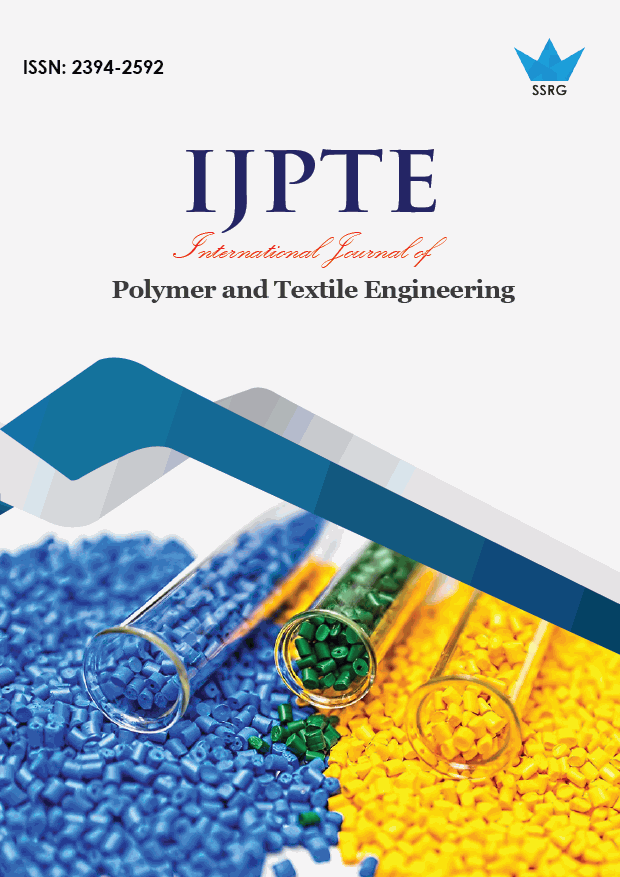Cotton Fibre Functionalization With Prepared Carboxymethyl Chitosan From Prawn Shell Waste: An Eco-Friendly Approach

| International Journal of Polymer and Textile Engineering |
| © 2021 by SSRG - IJPTE Journal |
| Volume 8 Issue 1 |
| Year of Publication : 2021 |
| Authors : Firoz Ahmed, Md. Saifur Rahman, Md. Ibrahim H Mondal |
How to Cite?
Firoz Ahmed, Md. Saifur Rahman, Md. Ibrahim H Mondal, "Cotton Fibre Functionalization With Prepared Carboxymethyl Chitosan From Prawn Shell Waste: An Eco-Friendly Approach," SSRG International Journal of Polymer and Textile Engineering, vol. 8, no. 1, pp. 9-14, 2021. Crossref, https://doi.org/10.14445/23942592/IJPTE-V8I1P103
Abstract:
Chitosan and its derivatives such as carboxymethyl chitosan (CMCh) are safe, biocompatible and eco-friendly substance for human usages. CMCh was prepared from chitosan (89% degree of deacetylation) by carboxymethylation reaction which was confirmed by FTIR spectroscopy. Obtained CMCh had an average degree of substitution was 1.20 determined by titrimetric analysis. Moisture content and ash content of Ch and CMCh were 10%, 9% and 2.33%, 14.39% respectively which affect cellulosic fibre properties. Functionalization of cotton with chitosan and CMCh introduces amino (1610 cm-1) and carboxyl groups (1737 cm-1) on the cellulose chain of the cotton fibre surface, causes the increment of reactive sites on the fibre backbone. The modified fibres were characterized by FTIR, SEM and thermal behaviours were also investigated by TGA, DTA and DTG. The unmodified and modified cellulosic fibres were dyed with two reactive dyes to compare the dyeability. Among them, modified fibre showed 10-15% higher dye exhaustion and better fastness properties than that of unmodified fibre.
Keywords:
Cotton, chitosan, carboxymethyl chitosan, functionalization.
References:
[1] Z.Y. Guo, R.E. Xingv, S. Liu, H. H. Yu, P.B. Wang, & C.P. Li. The synthesis and antioxidant activity of the Schiff bases of chitosan and carboxymethyl chitosan, Bioorganic Medicinal Chemistry Letter, 15(24), (2005) 4600–4603.
[2] S.H. Lim, & S.M. Hudson. Application of a fiber-reactive chitosan derivative to cotton fabric as an antimicrobial textile finish, Carbohydrate Polymer, 56, (2004) 227–234.
[3] I. Zhang, J. Guo, J. Zhou, G. Yang, & Y. Du. Blend membranes from carboxymethylated chitosan/alginate in aqueous solution, Journal of Applied Polymer Science, 77, (2000) 610–616.
[4] D. Gupta, & S.A. Haile. Multifunctional properties of cotton fabric treated with chitosan and carboxymethyl chitosan, Carbohydrate Polymers, 69 (2007) 164–171.
[5] S. Sun, & A. Wang. Adsorption properties of carboxymethyl-chitosan and cross-linked carboxymethyl-chitosan resin with Cu(II) as template, Separation and Purification Technology, 49 (2006) 197–204.
[6.] M.I.H. Mondal, F.I Farouqui, & F.M. Enamul Kabir,. Graft copolymerization of acrylamide and acrylic acid onto jute fibre using potassium persulphate as initiator”. Cellulose Chemistry and Technology, 36 (2002) 471-482.
[7] M.M Islam, M.I.H. Mondal, & M.A. Hoque. Synthesis of Chitosan Derivative for an Eco-Friendly Cotton Fiber Modifier with Enhanced Physico-Chemical Characteristics. In Cellulose and Cellulose Composites: Modification, Characterization and Applications, M.I.H. Mondal (Ed), Nova Science Publisher, New York, (2015) 81-98.
[8] R. Alam, M.A. Khan, S. Ghoshal, & M.I.H. Mondal. Study on the physico-mechanical properties of photo-cured chitosan films with oligomer and acrylate monomer. Journal of Polymer and Environment, 16,( 2008) 213-219.
[9] L.A. Cira, S. Huerta, G.M. Hall, & K. Shirai. Pilot scale lactic acid fermentation of shrimp wastes for chitin recovery, Process Biochemistry, 37(12), (2002) 1359-1366.
[10] T.K. Sini, S. Santhosh, & P.T. Mathew,. Study on the production of chitin and chitosan from shrimp shell by using Bacillus subtilis fermentation, Carbohydrate. Research, 342(16) (2007) 2423-2429.
[11] A.B.M.F. Alam, & M.I.H. Mondal. Utilization of Cellulosic Wastes in Textile and Garment Industries: 1. Synthesis and Grafting Characterization of Carboxymethyl Cellulose from Knitted Rag, Journal of Applied Polymer Science, 128(2), (2013) 1206-1212.
[12] L. Gerald, & A. Witucki,. Silane Primer: Chemistry and application of alkoxysilanes, Journal of Coatings Technology, 65(822), (1993) 57-60.
[13] H.C. Giles,. A laboratory course in dyeing (3rd Edn), Society of Dyers Colourist, Bradford, Yorksire, England, 79, (1984) 54-58.
[14] M.S. Yeasmin, &M.I.H. Mondal,. Synthesis of highly substituted carboxymethyl cellulose depending on cellulose particle size. International Journal of Biological Macromolecules, 80,( 2015) 725–731.
[15] H.K. No, S.H. Lee, N.Y. Park, & S.P. Meyers,. Comparison of physicochemical, binding and antibacterial properties of chitosan prepared without and with deproteinization process, Journal of Agricultural and Food Chemistry, 51(26) (2003) 7659-7663.
[16] A. Baxter, M. Dillon, K.D.A. Taylor, & G.A.F. Roberts,. Improved method for I.R. determination of the degree of N-acetylation of chitosan, International Journal Biological Macromolecules, 14,( 1992) 166-169.
[17] B.B. Rodriguez, J.A. Bolbot, & I.E. Tothill,. Urease-glutamic dehydrogenase biosensor for screening heavy metals in water and soil samples, Analytical Bioanalytical Chemistry, 380, (2004) 284-292.
[18] M.R. Kasaai, J. Arul, & G. Charlet, Intrinsic Viscosity–Molecular Weight Relationship for Chitosan, Journal of Polymer Science Part B Polymer Physics, 38(19),( 2000) 2591-2598.
[19] S.K. Rout,. Physicochemical, Functional, and Spectroscopic analysis of crawfish chitin and chitosan as affected by process modification, Journal of Carbohydrate Polymers, 16(3) (2001) 294-298.
[20] A. Tolaimate, J. Desbrieres, M. Rhazi, A. Alagui, M. Vincendon, & P. Vottero,. On the influence of deacetylation process on the physicochemical characteristics of chitosan from squid chitin. Journal of Polymer Research, 41(7) (2000) 2463-2469.
[21] M.I.H. Mondal, & F. Ahmed,. Cellulosic Fibres Modified by Chitosan and Synthesized Ecofriendly Carboxymethyl Chitosan from Prawn Shell Waste”, The Journal of the Textile Institute, 111(1) (2019) 49-59.
[22] A.I. Ojstrse, A. Doliska, & Fakin,. Analysis of reactive dyestuffs and their hydrolysis by capillary electrophoresis, Analytical Sciences, 24(12) (2008) 1581-1587.
[23] S.M. Lim, & S.M Hudson,. Application of a fiber-reactive chitosan derivative to cotton fabric as a zero-salt dyeing auxiliary, Coloration Technology, 120 (2004) 108–113.

 10.14445/23942592/IJPTE-V8I1P103
10.14445/23942592/IJPTE-V8I1P103